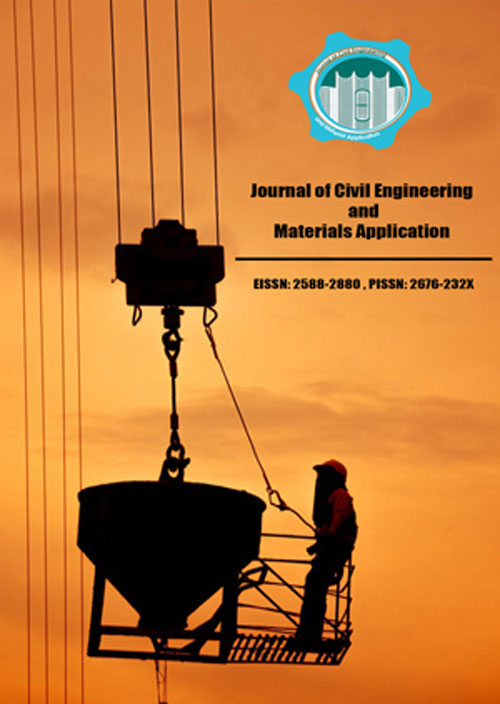فهرست مطالب

Journal of Civil Engineering and Materials Application
Volume:5 Issue: 1, Winter 2021
- تاریخ انتشار: 1400/02/04
- تعداد عناوین: 5
-
Pages 1-8Structural weakness in asphalt stems from the weakness of two components of asphalt, namely bitumen and stone materials. For many decades, various additives have been used to modify bitumen as well as various fibers to create a proper bond between bitumen and aggregates. The use of additives that have structural similarities or components with bitumen has also received more attention in recent years by various researchers. Carbon is one of the materials that can be described as very similar to bitumen. This material has recently been used in both pure and fiber forms for research on concrete. In this research, the addition of this material in fibers and powder combined with bitumen has been studied and compared. Experiments such as modulus of resistance, indirect tensile strength, and Marshall Strength have been used to evaluate asphalt mixtures' properties. This study showed that the use of carbon in both fibers and powder would bring positive results for asphalt mixtures.Keywords: Carbon powder, carbon fiber, Asphalt mix, Functional Properties
-
Pages 9-16An experimental study was conducted to determine the effect of cement kiln dust (CKD) and fly ash (FA) on compaction and strength characteristics of the high-plasticity clay obtained from a forest road in North of Iran. Accordingly, the soil was mixed with 15% CKD by dry weight the soil, and a partial replacement of the CKD with 10, 20, and 30% FA was applied to produce mixtures. The unconfined compressive strength tests were performed on specimens after a curing time 7 and 28 days. Also, the microstructures of untreated and treated specimens were examined using a scanning electron microscope (SEM). It was found that incorporation of CKD and FA leads to a decrease in the volume of pores in the soil matrix, which is due to the formation of calcium silicate hydrates and calcium aluminate hydrates gels. These cementitious compounds in the mixtures were presumed to be the significant factor contributing to strength improvements.Keywords: Soil stabilization, Cement kiln dust, Fly ash, Compressive strength, High-plasticity clay
-
Pages 17-24
High and improper speed is one of the most important factors in traffic accidents in many countries; as long as vehicle and road conditions remain constant, the severity of the accident increases by speeding the vehicle up. Therefore, injuries and damages caused by traffic violations and, consequently, road accidents are important and significant matters challenging the public health of society. Therefore, speed management is necessary to control the severity of accidents; thus, it is important to reduce casualties due to accidents. Speed cameras could be considered as one of the most important tools for managing the traffic flow on freeways. The methodology of the present study is quantitative and cross-sectional, and its main purpose is to investigate and analyze the role of traffic flow control methods on freeways and its effect on driver’s behavior on the Karaj-Qazvin freeway based on comparative and field studies. In this study, after reviewing the traffic flow control methods, a standard questionnaire was prepared to analyze the studied traffic flow control and their feasibility on the Karaj-Qazvin freeway and was distributed among the members of traffic police and drivers. Data were inputted into SPSS software, and research hypotheses were tested using linear regression. The results indicated that the number and type of video surveillance cameras, along with the simultaneous presence of police in the route, is effective to reduce speed and driving violations.
Keywords: Traffic, Speed, crash reduction, Camera, Regression -
Pages 25-33Current vibration-based damage detection consists of two main components, including modal parameter estimation methods and detection techniques. The second component employs the first part to detect and locate damage. Therefore, both are influenced by each other. They are typically predicted upon centralized data collection techniques, which significantly affect the ability to extract information on the structural health condition. Besides, the modal domain methods play an important role in structural damage identification and their popularity is much more than time domain or frequency domain approach. In the same line, an advanced decentralized database technology is required for the aforesaid techniques to overcome high maintenance cost of centralized approaches. Therefore, this study aims to improve the reliability and efficiency of current damage detection platforms through the integration of vibration-based methods and blockchain. To this end, a conceptual framework is proposed to make a connection between hardware and software components of structural damage detection.Keywords: structural health monitoring, Vibration-based damage detection, Blockchain, Big Data
-
Pages 35-45
Improving the level of road safety requires research that measures the effects of various variables on the frequency of accidents and takes practical measures to improve the level of road safety. In this study, first, the two inseparable axes of the Qazvin-Avaj suburban line were selected as a case study, and accident information was collected in the mentioned axis for the years 2010 to 2012. The number of accidents was selected as a dependent variable, and the variables of number of access roads and intersections, number of horizontal curves, and hourly traffic volume were selected as independent variables for modeling. The length of the day and night, depending on the spring and autumn hours, was divided into two parts, night and day, and a corresponding model was developed for each of them. In the end, the results were reported in such a way that the importance of effective variables in the day model is: number of access roads and intersections, hourly traffic volume, and then the number of horizontal arches. While for the night model, the variable number of horizontal arches had the most effect, followed by the number of access roads and intersections, and the least effective variable for the night model was the volume of hourly traffic.
Keywords: Accident Prediction Models, suburban roads, non-isolated two-lane roads

